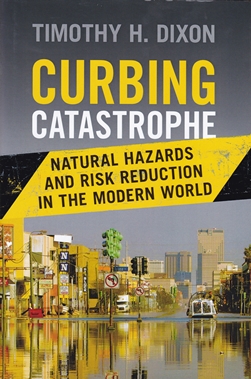 Curbing Catastrophe
Curbing Catastrophe
Natural hazards and risk reduction are such broad topics that any attempt to squeeze them into a single volume should backfire. Yet, written in an easy-to-read narrative style, each story in this book is presented in a compelling way that makes for a genuinely enjoyable and thought-provoking read.
It would certainly be impossible to cover the full topic in any depth. The author is a Professor in the School of Geosciences and Director of the Natural Hazards Network at the University of South Florida. He uses satellite geodesy and remote sensing data to study earthquakes and volcano deformation, coastal subsidence, groundwater extraction and glacier motion.
With this background one would expect the focus to be on the technical and scientific aspects of the hazards. However, this book actually covers these topics lightly. The level of detail is generally below that of undergraduate studies, and is really just to get non-technical readers up to speed ready for the main topics in the book: The importance of communication, the importance of understanding long-term processes, and the economic consequences of failure.
The book is based around case studies from the author's personal experience including the New Orleans flooding, the Haiti earthquake, the Fukushima nuclear accident, and climate change. Each case study is simply a medium for demonstrating failures in the main topics of the book and so are covered at various levels of detail, occasionally delving deep into areas of particular interest.
Recommendations are made throughout the book for scientists, engineers and politicians ranging from scientific communication to tax policy. Professor Dixon gives fantastic examples from his own scientific papers, showing how the cautious use of language in science communication blunts the message to the point where it becomes easy to ignore, and gives numerous examples of societal own-goals where poor planning is subsidised by taxpayers and a false sense of security is given to the people living in at-risk zones.
If you want to learn about the science of natural hazards, there are better sources. If you want to learn about communication of science and risk, or setting policy to reduce risk, this book is invaluable. You will take an entertaining and informative ramble through topics ranging from risk theory, the amount of caesium in wine, how vested interests bias the public discourse, the impact of building codes on fire safety, and the importance of companies confessing their errors openly and rapidly. This book will open your eyes.
Reviewed by Ross Roberts
CURBING CATASTROPHE: NATURAL HAZARDS AND RISK REDUCTION IN THE MODERN WORLD by TIMOTHY H DIXON, 2017. Published by Cambridge University Press 33pp ISBN: 978-1-107-03518-8 List Price: £21.99 W: www.cambridge.org/core/books/curbing-catastrophe/02789220833AB1F54C51B9D0628E639C
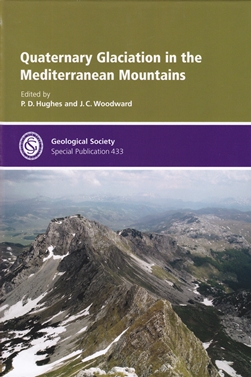 Quaternary Glaciation in the Mediterranean Mountains
Quaternary Glaciation in the Mediterranean Mountains
This special publication by the Geological Society of London presents 14 original research papers in the field of Quaternary Glaciation in the Mediterranean Mountains. The key objective was to bring together the latest work from leading specialists and to set out the wider significance of their findings. It certainly streamlines the past and present research knowledge and research techniques of this field, and also assesses the prospects for new studies, and outstanding research problems in Quaternary glaciation in the Mediterranean mountains.
It is a fascinating read, covering such rich and significant archive of the majestic mountain landscape that surrounds the Mediterranean Sea. The collection of 14 papers has something for everyone and provides an excellent starting point for anyone interested in Quaternary Glaciation.
It covers well the background and history of this field of research - not only the science but the human element too, the people involved and their backgrounds, making for a vivid and engaging read. It is well ordered, with a logical structure moving clockwise from North Africa around the Mediterranean, enriched with high quality maps, diagrams, data-tables and schematic diagrams. Each paper complements the others and provides readers with the opportunity to recognise the different methods that are used in studying past glacial environments. It shows the importance of working together to develop our understanding of the world around us. Interestingly it has highlighted how the timings of glaciation in the Mediterranean mountains influenced patterns of Palaeolithic settlement.
Of particular interest to me (and the focus of the author of the foreword, Bruno Messerli’s dissertation, 50 years previously) was the Sierra Nevada of Andalucia. With my mother recently moving to Spain, I was relishing the prospect of this book taking me on a journey through the glaciers of Spain, and I certainly wasn’t disappointed. The writing is aimed at graduate level, but assumes little technical knowledge. Techniques used are well explained and the methodologies of dating and state of current research clearly graded. For each of the geographical regions the earliest known publication, the dating methods applied and the current state of research are summarised, allowing the reader to gain an overview - as well as to easily locate a specific research method, or region.
It is a timely publication, with the status of glaciers rapidly changing year-on-year, and acts as a great stimulus for future questions about the majestic mountain landscape of the Mediterranean margin.
Reviewed by: Fiona Connor
QUATERNARY GLACIATION IN THE MEDITERRANEAN MOUNTAINS by P D HUGHES & J C WOODWARD (eds), 2017. Published by: Geological Society of London, Special Publications, 433. ISBN 978-1-86239-747-7 List price: £100.00. Fellows’ Price: £50.00. W: www.geolsoc.org.uk/sp433
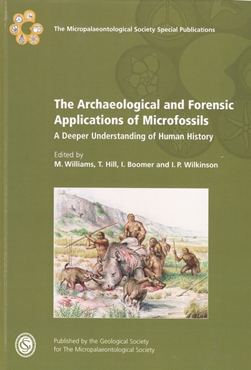 Archaeological and Forensic Applications of Microfossils
Archaeological and Forensic Applications of Microfossils
This Geological Society Publication for The Micropalaeontological Society presents 15 papers documenting the contribution of microfossils to archaeological and forensic study in relation to theory, method and interpretation. At 296 pages this volume is an engaging read with a wide range of topics and applications described by many leading experts. The volume is divided into three sections covering palaeoenvironmental applications in archaeology, provenancing analyses applied to archaeology, and forensic applications.
The papers hang together well and generally follow a chronological theme. They have been written in an accessible style that will be helpful for the many archaeologists with non-specialist knowledge of environmental science. The breadth of papers will appeal to a wide readership, as will the importance of some of the discussion topics.
Although all the papers are strong, particular standouts for me were the use of foraminifera and ostracods for palaeoenvironmental and palaeoclimate reconstruction of the Lower Palaeolithic site at Boxgrove in MIS13 - c. 0.5 million years ago (Whittaker and Parfitt), the evidence presented for dry islands or islets in ‘Doggerland’ 80km off the British coast at the beginning of the Neolithic period (Geary et al.) - much later than any previous palaeocoastline models based on sea level index points - and the discussion of pollen and non-pollen palnynomorph evidence for early farming activity in Late Mesolithic pollen records (Innes and Blackford).
The range and number of authors underscores the importance of collaborative working and the interdisciplinary research that has allowed the study of microfossils to add so much to archaeology and forensics. Whether used for investigating the evolution of past landscapes, past activities and impacts of humans within and on the landscape, unravelling the interplay of humans, landscape, vegetation and climate, or in the conviction and prosecution of criminals, this important and up-to-date volume will form a regular work of reference for student and specialist alike.
The papers are predominantly UK-focused, although there are excursions into the countries of the Mediterranean fringe, including Italy, Macedonia and Israel. However, the findings discussed in many papers will be of interest to much more than a UK-only readership, given that the Palaeolithic, Mesolithic and Neolithic transition papers discuss important data of north-west European relevance, and the methodological issues tackled by most of the papers have a more universal application.
This eclectic collection of papers in a compact volume do an admirable job of highlighting the important, although sometimes overlooked, contribution microfossil studies make to many of our fundamental questions about the past, the evolution of landscapes and the solving of felonies, including war crimes. This volume will be placed on one of my more easily-accessed bookshelves.
Reviewed by: Clive Waddington
THE APPROACHES AND FORENSIC APPLICATIONS OF MICROFOSSILS. A DEEPER UNDERSTANDING OF HUMAN HISTORY Edited by: M WILLIAMS, T HILL, I BOOMER AND I WILKINSON 2017 Published for The Micropalaeontological Society by The Geological Society. ISBN: 978-1-78620-305-2 List Price: £100 Fellows price: £60.00 W: www.geolsoc.org.uk/TMS007
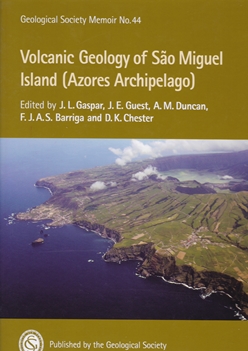 Volcanic Geology of São Miguel Island
Volcanic Geology of São Miguel Island
The large-format memoir volume is made up of 22 separate stand-alone papers in which São Miguel’s location and evolution, as well as the Azorean Archipelago as a whole, are explained with respect to the triple junction between the North American, Eurasian and Nubai plates, the Mid Oceanic Ridge and the Terceira Rift Zone.
Volcanism is still active on São Miguel. A brief description of the types of volcanoes, and the eruption types are presented. Volcanic and landslide hazards with respect to the geomorphology and geology of São Miguel are described, as are some eruptions and their consequences. A number of damaging landslides have occurred since colonization of the Azores began in the 15th Century. A series of maps depicts landslide hazard potential on the island, with a discussion on landslide-monitoring activities. Several historical accounts of damage caused by landslides to houses, villages and farms are also given.
The history of damaging earthquakes on or near São Miguel is discussed in depth. Modelling of seismic hazard, vulnerability and risk is discussed in relative detail, using modern seismic hazard and risk-assessment methods. One of the main reasons why the island displays high seismic risk with only a moderate level of seismic hazard, is that much of the older building stock was built from stone rubble, without the benefit of modern building codes.
A discussion on degassing of carbon dioxide and radon from soil takes the reader from the subsurface and into several building types. Some information on the effects of environmental conditions and the concentration of CO2 or radon in buildings is included. Mitigation of volcanic gases by the use of barriers and passive venting are the only gas-reduction techniques discussed.
Overall, I found this book to be an excellent general resource for the geology, seismicity, seismic hazards, volcanic hazards and related effects for São Miguel, as well as a basic resource for the geology of the eastern portion of the Azorean Archipelago.
Reviewed by: Robert Anderson
VOLCANIC GEOLOGY OF SÃO MIGUEL ISLAND (AZORES ARCHIPELAGO) by J L GASPAR, J E GUEST, A M DUNCAN, F J A S BARRIGA AND D K CHESTER (eds) 2015. Published by: The Geological Society, ISBN: 978-1-86239-731-6 List Price: £95.00 Fellows Price: £47.50 W: https://www.geolsoc.org.uk/M0044
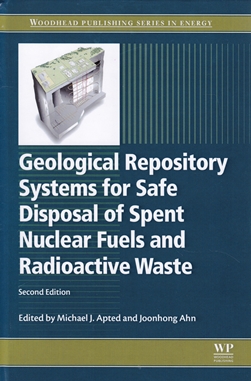 Geological Repository Systems
Geological Repository Systems
From the mid-20th Century, civil nuclear power generation, military R&D and nuclear weapons production, together with the widespread use of radioactive materials in medicine, academia and industry, have all have generated significant radioactive wastes of various forms, quantities and levels of radioactivity. Geological disposal has been selected, developed and implemented over the past 50 years by many nuclear ‘active’ nations, as the safest and most effective final disposal method for the management of these waste materials.
The volume presents 26 chapters arranged in five thematic sets. Chapters in Part One introduce the topic and context of geological disposal, providing an overview of near-surface, intermediate depth and deep borehole disposal (covering low, medium and high-level wastes).
Part Two describes the different types of repository systems (crystalline, clay and salt-hosted) and methods of repository site surveying and construction. Chapters in Part Three focus on the repository engineered barrier systems, covering nuclear waste canisters through to buffer and backfill materials. Finally, chapters in Parts Four and Five address aspects of repository safety, security and social ‘acceptability’, concentrating on repository performance assessment, radiation protection, environmental monitoring and social engagement. Each chapter contains its own individual reference section.
This is the second edition of this established reference work, and has been comprehensively revised, updated and expanded (the editors claim that some 25% of new material has been included on contemporary topics of importance). The volume critically reviews the current technologies and scientific methodologies relating to the long-term, safe geological disposal and management of nuclear wastes. In addition to scientific and technical aspects, the political, regulatory and societal issues involved are also discussed, using key examples to illustrate both international and national perspectives on issues raised.
The primary readership is anticipated to be practising geoscience professionals within both UK and international radioactive waste management industries. However, this volume also provides a rigorous and comprehensive public information source for the general scientific or environmentally concerned reader, and governmental or regulatory official requiring a thorough contemporary understanding of the scientific developments informing their decision-making. A recommended read and valuable reference work.
Reviewed by: Mark Griffin
GEOLOGICAL REPOSITORY SYSTEMS FOR SAFE DISPOSAL OF SPENT NUCLEAR FUELS AND RADIOACTIVE WASTE (SECOND EDITION) by MICHAEL J APTED & JOONHONG ANG (editors). Woodhead Publishing Series in Energy. 2017. Elsevier. ISBN 978-0-08-100642-9. Hbk. 802pp. List Price: £290.00. W: www.elsevier.com/books-and-journals
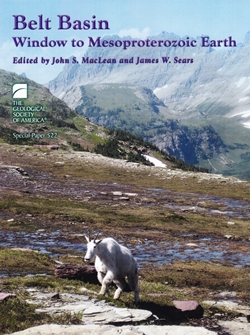 Belt Basin: Window to Mesoproterozoic Earth
Belt Basin: Window to Mesoproterozoic Earth
This book provides a detailed review of aspects of the Belt Basin, which covers around 200,000km2 of Montana, Idaho and adjacent Canada. The basin fill is around 20km of mainly clastic sediments deposited between 1500 and 1370 Ma in an intracontinental rift basin that subsequently underwent numerous episodes of tensional, compressional and strike-slip tectonism and igneous activity until as recently as the Miocene. Despite metamorphism to greenschist grade, sedimentary structures are well preserved.
The first four papers examine aspects of stratigraphy and sedimentology, including whether the sediments were lacustrine or marine - not easy in successions where fossils are rare at best. Likely environments in parts of the basin were playa lakes and flash floods across land surfaces devoid of vegetation; but elsewhere, tidal to marine shelf environments are inferred.
The next four papers deal with the Lemhi sub-basin, whose 15km-thick succession is lithologically monotonous, completely lacking in fossils and repeatedly faulted, making correlation within it especially difficult. The last chapter considers the origin of strata-bound hydrothermal Co and Cu ores.
Three papers follow, covering aspects of geochemistry and geochronology. Chapter Nine examines the iron mineralogy in the lower part of the column, concluding that the water column was shallow and fully oxygenated but that sediments underwent diagenesis almost immediately in a sub- to anoxic sulphide-rich environment. The chapter goes on to consider the implications of this for early life forms. Chapter 10 discusses a major geochemical survey of Proterozoic mafic igneous rocks in the basin. Previously, only two LIPs were identified; new work recognises 17 different geochemical signatures.
The final three chapters cover geophysics and structural geology. They include a discussion of a deep, low resistivity layer identified on MT, which is nowhere exposed at surface but is believed to contain numerous repeated sulphide-rich layers emplaced during basaltic underplating of the attenuated continental crust during the basin’s early history. Other chapters consider the development of early rift-defining growth faults, their later compressional reactivation, and the formation of large-scale gravity sliding of the thick carapace above a deep-seated intrusive magma wedge that migrated upwards and eastwards over a long period.
The book is well written and adequately illustrated, with many colour figures, but no index. Other recent books on the same general theme conclude that Early Proterozoic Earth closely resembled the Earth we know now. This volume reaches the same general conclusion but finds differences, and highlights them accordingly. I recommend it to those doing research in this fascinating period of geological history.
Reviewed by: Pete Webb
BELT BASIN: WINDOW TO MESOPROTEROZOIC EARTH by JOHN S MACLEAN AND JAMES W SEARS (eds) Published by: The Geological Society of America (SP 522). Publication date: 2016 ISBN: 978-0-8137-2522-2 (hbk) 384pp. List price: £57.50; GS Fellows £40 W: www.geolsoc.org.uk/USPE522